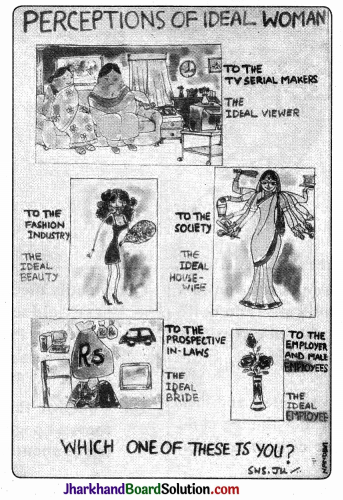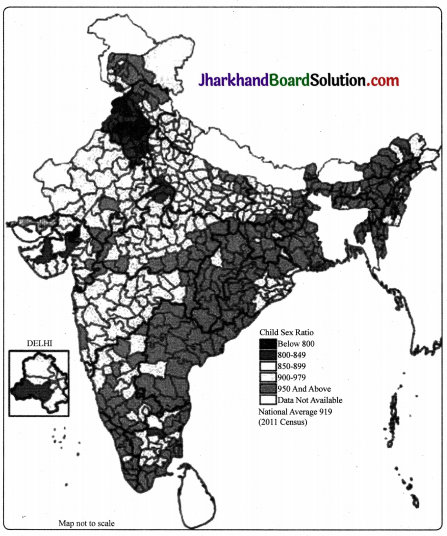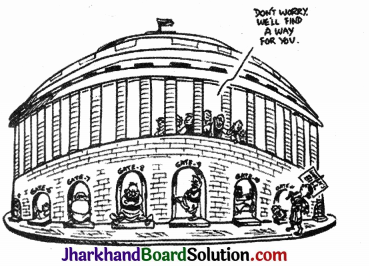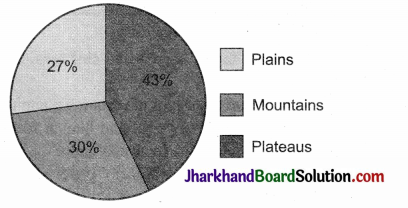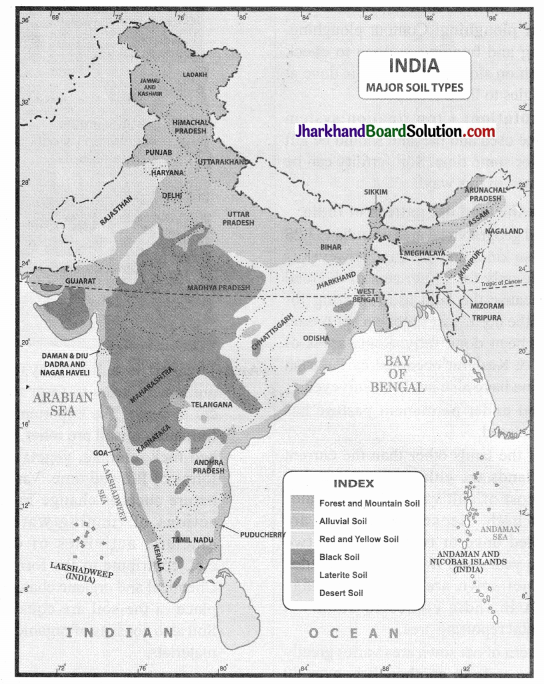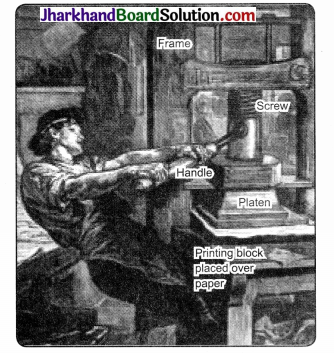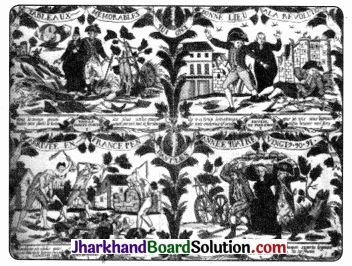JAC Board Class 10th Social Science Solutions History Chapter 5 Print Culture and the Modern World
JAC Class 10th History Print Culture and the Modern World InText Questions and Answers
Page 108
Question 1.
Imagine that you are Marco Polo. Write a letter from China to describe the world of print which you have seen there.
Answer:
Dear Robert Hope, this letter finds you in happy and cheerful disposition. Presently, I am in China, studying about the wonderful technique that Chinese are using for printing. With paper it is possible to produce manuscripts, carefully written by scribes. China has the technology of woodblock printing. Books are being produced with this technique to spread knowledge and educate people.
Chinese paper is reaching Europe through the silk route. I am planning to bring this technology of woodblock printing to Italy when I return home. Please permit me to end my letter here. I shower you with lots of love and affection and regards to your family members. Your best friend Marco Polo.
Page 111
Question 2.
You are a bookseller advertising the availability of new cheap printed books. Design a poster for your shop window.
Answer:
Self-help Hints:
- Make a poster with the blurb of the book.
- ighlight the name and the author of the book.
- Write a few points in bullets about the book. Pictures or cartoons may be used to represent the characters and the story in the book. The sentences should be crisp, lucid and simple. The cartoons or caricatures have to be easy to understand.
- The price has to be mentioned clearly on the book.
- The book may be cheap but it has to be appealing to the readers. It should be colourful. The publisher’s name should be printed clearly.

Page 113
Question 3.
Write briefly why some people feared that the development of print could lead to the growth of dissenting ideas.
Answer:
Print created the possibility wide circulation of ideas, and introduced new world of debate and discussion. Even those who did not agree with the established authorities could now print and circulate their ideas. Through the printed message, they could influence people to think differently, and move them to ‘action. Therefore, some feared that if there was no control over what was printed and read, rebellious and irreligious though%might spread.
Page 116
Question 3.
Imagine that you are a cartoonist in France before the revolution. Design a cartoon as it would have appeared in a pamphlet.
Answer:
Self-help Hints:
- Through cartoon or caricature contrast between the monarchy and the common man has to be reflected.
- The lifestyle of monarchy should be reflected in such a way that it shows they were absorbed in only sensual pleasures. They were not concerned about the issues of the common people.
- That the common people suffered immense hardships should be clearly shown through the cartoon.
- Write few points on effects these cartoons/ caricatures had on the thinking of people.
Question 5.
Why do some historians think that print culture created the basis for the French Revolution? (Page 116, Discuss)
Answer:
Historians have put forward three arguments to emphasise that print culture created the basis of French Revolution.
(i) Print popularised the ideas of the Enlightenment thinkers. Collectively, their writings provided a critical commentary on tradition, superstition and despotism. They argued for the rule of reason rather than custom, and demanded that everything be judged through the application of reason and rationality.
They attacked the sacred authority of the Church and despotic power of the state, thus eroding the legitimacy of social order based on tradition. Those who read the writings of Voltaire and Rousseau saw the world through new eyes that were questioning, critical and rational.
(ii) Print created a new culture of dialogue and debate. All values, norms and institutions were re-evaluated and discussed by a section of public that had become aware of the power of reason, and recognised the need to question existing ideas and beliefs. Within this public culture, new ideas of social revolution came into being.
(iii) By the 1780s there was an outpouring of literature, especially cartoons and caricatures that mocked the royalty and criticised their morality, In the process it raised questions about the existing social order. The monarchy neglected the sufferings of the common man and was only involved in sensual pleasures.

Page 118
Question 6.
Look at Fig. 13. What impact do such advertisements have on the public mind? Do you think everyone reacts to printed material in the same way?
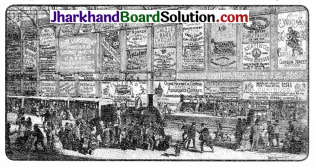
Answer:
Advertisements play an important role in attracting consumers to a product and shaping the opinion of the people. With various visual appeals, such as catchy slogans, tag lines and images an advertisement tempt people towards a certain product. People may not react to the printed material in the same way. It depends on their needs and wants, their age, their likes and dislikes, etc.
Question 7.
Look at Figs. 19, 20 and 21 carefully.
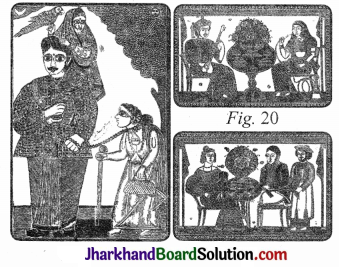
(a) What comments are the artists making on the social changes taking place in society?
(b) What changes in society were taking place to provoke this reaction?
(c) Do you agree with the artist’s view ?
Answer:
(a) These three images reflect the transformation taking place in the society. Women began to read, write and they were also written about. Women started educating themselves. They started demanding equal status and wanted to come out of the patriarchal system of society and dominance.
(b) Education among women was encouraged by many liberal husbands and fathers. Women did not want to confine themselves only to domestic affairs but also to get involved in national movements and social activities.
(c) No, I do not agree with the artist’s view because women should be treated equally. They should not be dominated by their male partners, be it their father, brother, or husband. They should be given their space to express their opinion and actively participate in the progress and development of the society.
JAC Class 10th History Print Culture and the Modern World Textbook Questions and Answers
Write in brief:
Question 1.
Give reasons for the following:
(a) Woodblock print only came to Europe after 1295.
(b) Martin Luther was in favour of print and spoke out in praise of it.
(c) The Roman Catholic Church began keeping an Index of Prohibited books from the mid-sixteenth century.
(d) Gandhi said the tight for Swaraj is a fight for liberty of speech, liberty of the press, and freedom of association.
Answer:
(a) After many years of exploration in China, Marco Polo, a great explorer, returned to Italy in 1295. China already had the technology of woodblock printing. Marco Polo brought this knowledge back with him. Then Italians produced books l with wood blocks and soon the technology
spread to other parts of Europe.
(b) (i) Martin Luther had said ‘Printing is the ultimate gift of God and the greatest one’. In 1517, The Religious Reformer wrote Ninety Five Theses criticising many of the practices and rituals of the Roman Catholic Church.
(ii) A printed copy of this was posted on a church door in Wittenberg. It challenged the Church to debate his ideas.
(iii) Luther’s writings were immediately reproduced in vast numbers and read widely This led to a division within the Church and to the beginning of the Protestant Reformation.
(c) (i) Print and religious literature inspired many distinctive individual interpretations of faith even among little-educated working people.
(ii) In the sixteenth century, Menocchio, a miller in Italy, began to read books and reinterpreted the message of the Bible and formulated a view of God and Creation that enraged the Roman Catholic Church.
(iii) When the Roman Church began its inquisition to repress heretical ideas, Menocchio was hauled up twice and ultimately executed.
(iv) The Roman Church, troubled by such effects of popular readings and questionings of faith, imposed severe control over publishers and booksellers, and began to maintain an Index of Prohibited Books from 1558.

(d) (i) In 1922, Gandhiji strongly advocated the importance of liberty of speech, liberty of the press and freedom of association.
(ii) The government tried to curb these three powerful vehicles of expressing and cultivating public opinion.
(iii) Gandhiji encouraged the people to fight for Swaraj, the Khilafat which meant fight for liberty of speech, liberty of the press and freedom of association.
Question 2.
Write short notes to show what you know about:
(a) The Gutenberg Press
(b) Erasmus’s idea of the printed book
(c) The Vernacular Press Act
Answer:
(a) (i) Johannes Gutenberg developed the first-known printing press in the 1430s.
(ii) From his childhood he had seen wine and olive presses. Subsequently, he learnt the art of polishing stones, became a master goldsmith, and also acquired the expertise to create lead moulds used for making trinkets.
(iii) Drawing on this knowledge, Gutenberg adapted existing technology to design his innovation. The olive press provided the model for the printing press, and moulds were used for casting the metal types for the letters of the alphabet.
(iv) By 1448, Gutenberg perfected the system. The first book he printed was the Bible. About 180 copies were printed and it took three years to produce them.
(v) The production was fast compared to the standards of that time. It was a moveable type printing machine. It could print 250 sheets on one side per hour.
(b) (i) Erasmus was a Latin scholar and a Catholic Reformer. He was against excesses of Catholicism but expressed a deep anxiety about printing.
(ii) Though he appreciated that books may give knowledge, too many books will create a glut. The printers may fill the books with stupid, ignorant, slanderous, scandalous, raving, irreligious and seditious things. This may lead to important publications losing their value.

(c) (i) After the Revolt of 1857, the enraged Englishmen demanded a clamp down on . the ‘native’ press. Modelled on the Irish Press Laws, the Vernacular Press Act was passed in 1878.
(ii) It provided the government with extensive rights to censor reports and editorials in the vernacular press.
(iii) The government kept regular track of the vernacular newspapers published in different provinces. When a report was judged as seditious, the newspaper was warned.
(iv) If the warning was ignored, the press was liable to be seized and the printing machinery confiscated.
Question 3.
What did the spread of print culture in nineteenth century India mean to:
(a) Women
(b) The poor
(c) Reformers
Answer:
(a) (i) With the spread of print culture in the nineteenth century in India, women began to read,
(ii) Lives and feelings of women began to be written about in vivid and intense ways.
(iii) Liberal husbands and fathers began educating their womenfolk at home, and sent them to schools when women’s schools were set up in the cities and towns after the mid-nineteenth century.
(iv) There were many journals which published “writings by women and also explained why wSmen need to be educated.
(v) However, few families thought otherwise. Conservative Hindus believed that a literal’girl would be widowed and Muslims feared that educated women would be corrupted by Urdu romances.
(vi) Sometimes rebel women defied prohibition. In East Bengal, in the early nineteenth century, Rashsundari Debi, a young married girl in a very
orthodox household, learnt to read in the secrecy of her kitchen. The first full- length autobiography published in the Bengali language in 1876, Amur Jiban, was written by her.
(vii) From the 1860s, a few Bengali women like Kailashbashini Debi wrote books highlighting the experiences of women about how women were imprisoned at home, kept in ignorance, forced to do hard domestic labour and treated unjustly by the very people they served.
(viii) In the 1880s, in present-day Maharashtra, Tarabai Shinde and Pandita Ramabai wrote with passionate anger about the miserable lives of upper-caste Hindu women, especially widows.

(b) (i) Very small cheap books were available in the markets in nineteenth-century Madras towns and sold at crossroads, allowing poor people travelling to markets to buy them.
(ii) Public libraries were set up from the early twentieth century, expanding the access to books.
(iii) Issues of caste discrimination began to be written about in many printed tracts and essays. Jyotiba Phule wrote about the injustices of the caste system in his Gulamgiri (1871). In the twentieth century, B.R. Ambedkar in Maharashtra and E.V. Ramasamy Naicker in Madras wrote powerfully on caste and their writings were read by people all over India.
(iv) Local protest movements and sects also created popular journals and tracts criticising ancient scriptures and envisioning a new and just future.
(v) Kashibaba, a Kanpur millworker, wrote and published Chhote Aur Bade Ka Sawal in 1938 to show the links between caste and class exploitation.
(vi) Another Kanpur mill worker wrote under the name Sudarshan Chakr (1935-1955), and his work was published in a collection called Sacchi Kavitayan.
(vii) By the 1930s, Bangalore cotton mill workers set up libraries to educate .themselves, following the example of Bombay workers.
(c) (i) From the early nineteenth century, a wider public could participate in public discussions and express their views.
(ii) Some criticised existing practices and campaigned for reform, while others countered the arguments of reformers. The debates were carried out in public and in print.
(iii) This was a time of intense controversies between social and religious reformers and the Hindu orthodoxy over matters like widow immolation, monotheism, Brahmanical priesthood and idolatory.
(iv) Rammohun Roy published Sambad Kaumudi from 1821 and the Hindu orthodoxy commissioned Samachar Chandrika to oppose his opinions.
(v) The Deoband Seminary, founded in 1867, published thousands of fatwas telling Muslim readers how to conduct themselves in their everyday lives, and explaining the meanings of Islamic doctrines.
NCERT ‘Discuss’ Questions
Question 1.
Why did some people in eighteenth century-Europe think that print culture would taring enlightenment and end despotism?
Answer:
By the mid-eighteenth century, there was a common conviction that books were a’Sneans of spreading progress and enlightenment:
- Many believed that books could change the world, liberate society from despotism and tyranny, and herald a time when reason and intellect could rule.
- Print popularised the ideas of enlightenment thinkers. They argued for the rule of reason and rationality. Their writings collectively provided a critical commentary on tradition, superstition and despotism.
- They attacked the sacred authority of the Church and the despotic power of the state, thus eroding the legitimacy of a social order based on tradition.
- The print created a new world of debate and discussion. Even those who disagreed with established norms and authorities could now print and circulate their ideas.
- There was a print revolution: It transformed the lives of the people, changing their relationship to information and knowledge, and with institutions and authorities.
- It influenced popular perceptions and opened up new ways of looking at things.

Question 2.
Why did some people fear the effect of easily available printed books? Choose one example from Europe and one from India.
Answer:
- Print created the possibility of wide circulation of ideas, and introduced a new world of debate and discussion. Even those who disagreed with established authorities could now print and circulate their ideas.
- Through printed message, they could persuade people to think differently, and move them to action. Print and popular religious literature stimulated many distinctive individual interpretations of faith even among the little-educated working people.
- Menocchio, a miller in Italy reinterpreted the message of the Bible and formulated a view of God and Creation that enraged the Roman Catholic Church. They began in question to repress heretical views, hauled up Menocchio twice and ultimately executed him.
- Troubled by such effects of popular readings and questionings of faith, the Roman Church imposed severe control over publishers and booksellers, and began to maintain an Index of Prohibited Books from 1558.
- In India, many conservative Hindus believed that a literate girl would be widowed and Muslims feared that the educated women would be corrupted by reading Urdu romances.
Question 3.
What were the effects of the spread of print culture for poor people in nineteenth century India?
Answer:
- In the nineteenth century India, very cheap small books were brought to the markets .and sold at crossroads, allowing poor people travelling to markets to buy them.
- Local rich patrons set up many public libraries in cities and towns from the early twentieth century, expanding the access to books.
- From the late nineteenth century, issues of caste discrimination began to be written about in many tracts and essays. Jyotiba Phule, the Marathi pioneer of Tow caste’protest movements, wrote about the injustices of the caste system in his Gulamgiri (1871).
- In the twentieth century, B.R. Ambedkar in Maharashtra and E.V. Ramasamy Naicker- in Madras wrote powerfully on caste apd their writings were read by people all over India.
- Local protest movements and sects also created popular journals and •tracts ‘c’riticising ancient scriptures and envisioning a new future.
- Kashibaba, a Kanpur millworker wrote and published Chhote Aur Bade Ka Sawal in 1938 to show the links between caste and “class exploitation.
- Another Kanpur millworker wrote under the name Sudarshan Chakra between 1935 and 1955, published Sacchi Kavitayan.
- By the 1930s, Bangalore cotton mill workers too set up libraries to educate themselves like the Bombay workers.
Question 4.
Explain how print culture assisted the growth of nationalism in India.
Answer:
Print culture assisted the growth of nationalism in various ways in India:
(i) The vernacular press was very effective in the spread of nationalism. Raja Ram Mohan Roy published the Sambad Kaumudi from 1821, Bal Gangadhar Tilak published Kesari and Gangadhar Bhattacharya brought out the weekly Bengal Gazette. There was The Hindu, Bombay Samachar, The Indian Mirror, and Amrita Bazar Patrika.
(ii) They reported on colonial misrule and encouraged nationalist activities. Attempts to throttle nationalist criticism provoked militant protest.
(iii) Bal Gangadhar Tilak wrote with great sympathy in Kesari, which led to his imprisonment in 1908, provoking in turn widespread protests all over India.
NCERT ‘Project’ Work ,
Question 1.
Find out more about the changes in print technology in the last 100 years. Write about the changes, explaining why they have taken place, what their consequences have been. Self-help
Hints:
- Trace the changes in print technology in chronological order.
- Initially people wrote on palm leaves with feather dipped in ink.
- The earliest kind of print technology was developed in China, Japan and Korea. Explain woodblock printing of China. Name the oldest Japanese book.
- Through the silk route, print technology entered Europe.
- Johann Gutenberg developed the first- known printing press in the 1430s. Discuss how it was an improvement from woodblock printing.
- Discuss how the print technology affected the society and lives of people.
- Reference Weblinks: https://www. britannica.com/topic/printing-publishing ttps://www.britannica.com/technology/ printing-press
![]()
![]()
